The thought of tracking macros scares many people into delaying their keto journey, but it’s really not as complicated at it might seem. There are some great tools available that make the whole process so easy.
Also, some people are not aware that you do not need to calculate your macros, you can just wing it and wait for ketosis and fat adaption to kick in. It might just require more patience and it certainly depends on the results you’re after and the results you’re getting from your chosen method.
If your goal with keto is to lose weight, then you could start losing in your first week, simply by switching to the keto approved food list! I would recommend, however, that if you’re aiming to treat ME/CFS or any other chronic illness, like I am, that you track from the start to make sure you become fat adapted as quickly as possible because that is where the ‘magic’ happens.
In Part 1 of this series, we looked at setting goals and calculating your macros. In this second part, we will look at how you can easily track your macros on a daily basis using some very handy apps. I will show you how to set them up. It is way easier than it seems at first!
Part 3 will be about which foods to eat and then in Part 4 I’ll explain how to plan your meals using these tools so you take all the guesswork out of staying within your macro limits.
Once you have calculated your macro targets with a keto calculator (part 1), you will need to install a tracking app on your phone (or you can use the related website if you prefer using the computer) I prefer the phone app because I can carry the phone to the kitchen, scan bar-codes and adjust numbers while preparing the meals.
The great thing about these apps is they are designed to do all the calculations for you! You simply scan bar-codes of the items you use in each meal or use the search tool to type the name of the item, tell it how much of that item you used, and it will work out your macros for you. It’s so easy and no need to calculate anything yourself.
Having a kitchen scale and measuring cups and spoons will make this process even easier and over time you learn how much of each item is a good size portion and you wont even need to weigh and measure anymore.
It’s really quite straightforward and takes all the guesswork out of it. Below are 2 popular tracking apps I see people referring to most.
As I mentioned in part 1 of this series, my personal macros are currently: – Consume about 1452 calories. – Around 117g should be fat.- Up to 20g should be carbs.- At least 78g should be protein. Being housebound and quite inactive means that I only burn around 1400 calories a day, as my condition improves, I’ll increase activity levels and will need to readjust my macros to accommodate my new caloric requirements because the more we move, the move we burn.
I’ll show you how I’ve set up the tracking apps using my macros above.

My Fitness Pal
My Fitness Pal is an international tool that has a huge database of products from all over the world, so you’re bound to find just about anything you search for. It’s free, you do not need to pay for the pro version to make good use of it, the free version will be sufficient.

Fig.1 MFP main feed
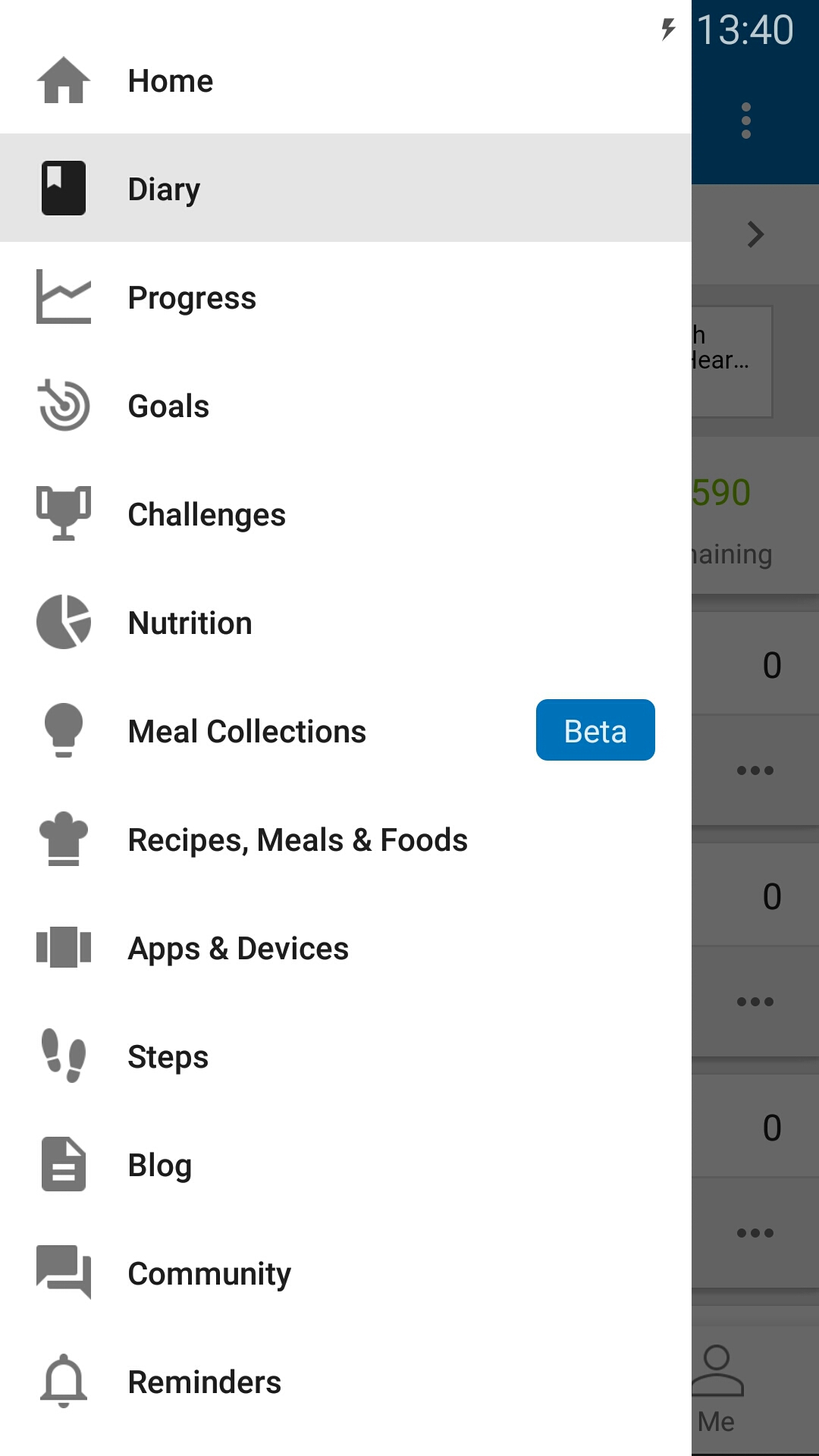
Fig.2 MFP menus

Fig.3 MFP diary
Some useful features
- A minimalist overview of your daily macro intake and remaining allowance, text with a progress bar.
- Easy to read and user friendly navigation, menu available from all pages.
- Ability to create your own recipes and import recipes from websites
- Save any dish (or collection of ingredients) you use regularly as a meal for future use
- It remembers your favourite or most used items and the last measurements of each and will suggest them first when you use the search function
- A huge community platform where you can connect with others, update your status, comment and encourage each other and take part in challenges. (all optional, you can also keep your profile private and not get involved)
- It’s free (you can choose to upgrade to a monthly subscription of £3.33 paid annually at £39.99/year to access all the bells and whistles. If you’re only tracking your macro nutrients and creating or saving recipes, you won’t require the pro version, the social community features are free too).
Setting up My Fitness Pal

Fig.4 MFP goals
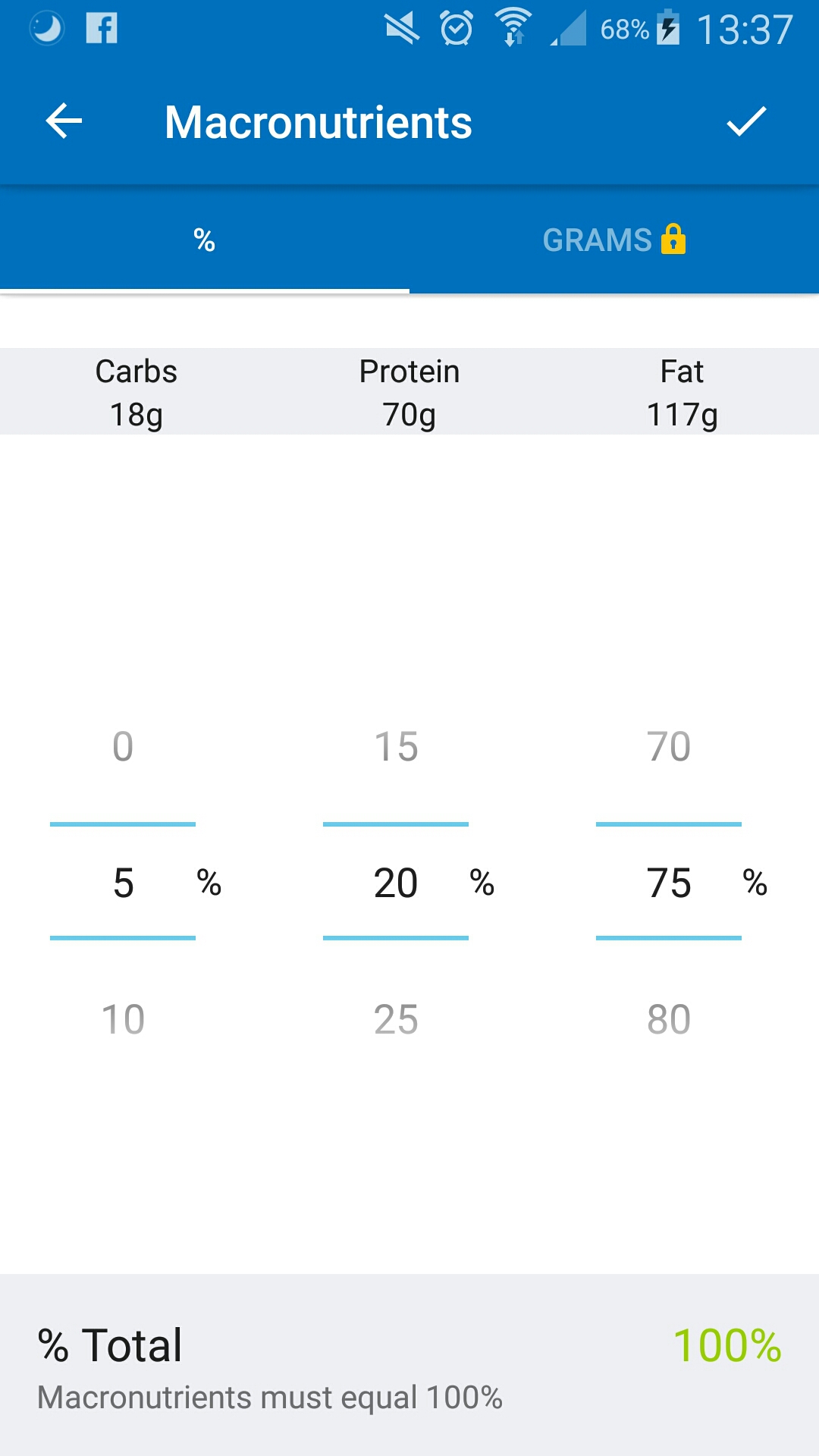
Fig.5 MFP macro settings
You can see above, I am not able to get all my macros precisely where they need to be using the free version of MFP as only the % settings are available in the free version of the app, but I can get them pretty close and it’s worked fine for me:
– I’ve set my carbs to 5% which gives me 18g (below 20g is the goal here, so that’s fine). – My protein is set to 20% which gives me a target of 70g (at least 70, preferably more).- My fat is set to 75% which gives me a target of 117g (perfect!).
This might seem confusing to start with, but it’s not something that you will need to calculate and worry about everyday. Your goal here is to set the dials so that your grammes reflect the macro goals you calculated with the macro calculator. If you can’t get it precisely right, it’s okay to get it as close as possible.
Remember:– The carb amount is a limit, you want to have no more than that amount.- The protein amount is a goal, you can exceed it, but this is your daily target to meet.- The fat amount is a limit, you can have up to this amount daily if necessary, but if your aim is to lose weight, then eat less than this amount each day and your body will start burning it’s stored fat when it needs more fuel. (I’m maintaining, so I eat at least 100g a day or more)
Once it’s set here, the app will simply show you a bar graph and pie chart for each day and you can see in a visual way how far you’ve gone towards your targets and how much you have left to consume (see Figure 6 & 7 below). It’s pretty straight forward once the settings are in place.
Daily overview

Fig.6 MFP nutrients tab
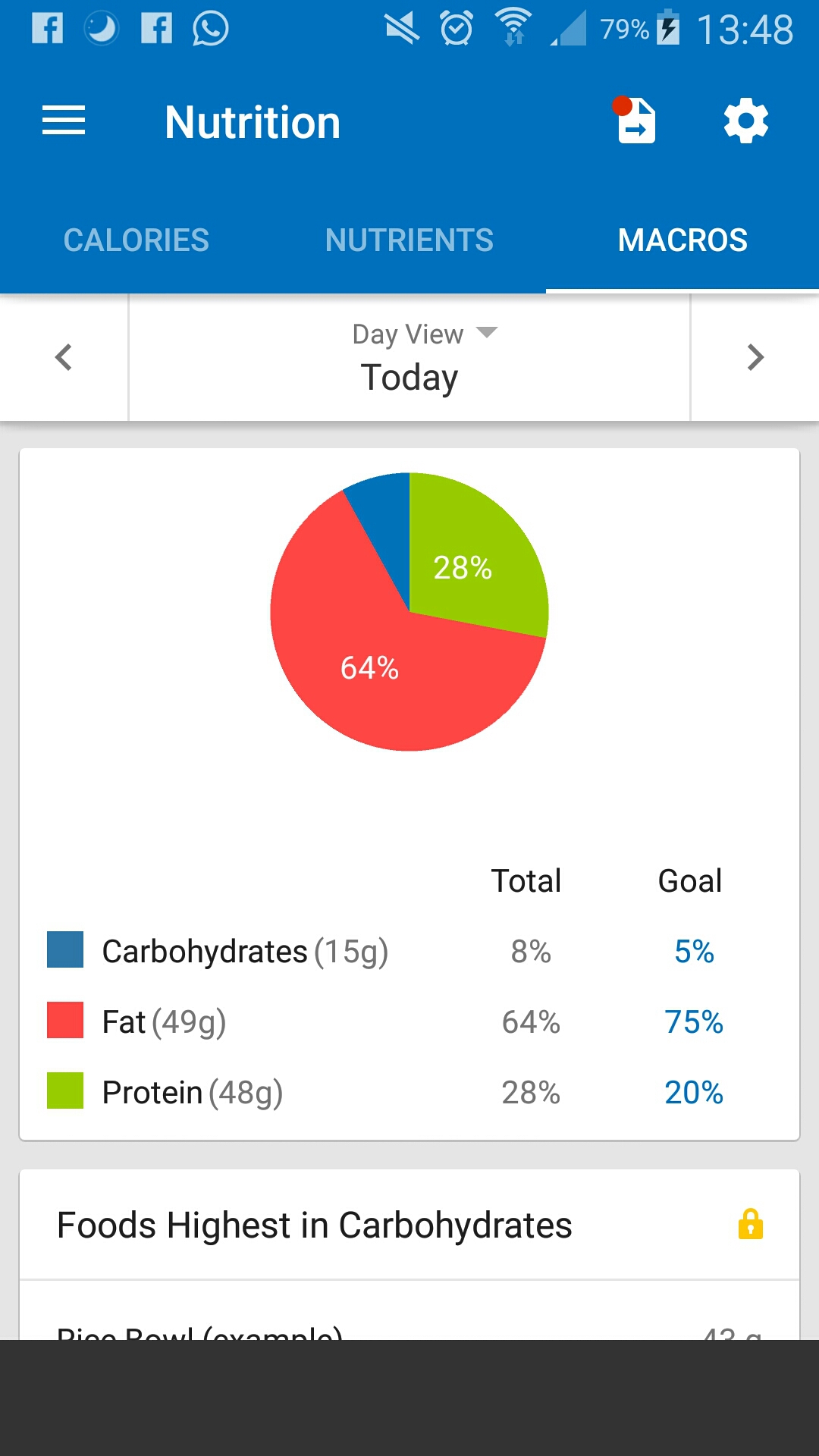
Fig.7 MFP macros tab
In Figure 6 you can see the Nutrients tab which is the one I focus on because it’s exact. It tells me how much I’ve eaten, what my goal is and how much I can still eat for that day. Very straight forward. I have highlighted the information I look at, I ignore everything else.
The Macros tab in Figure 7 works on percentages, so although it’s a pretty pie chart, it is relative to how much you’ve eaten. This means that you can reach your % without having eaten enough food for the day or even if you’ve overeaten! Not ideal if weight management is an issue.
You can see how for somebody with brain fog, like me, monitoring the grammes in the Nutrients tab is much better than monitoring the percentages in the Macros tab. It takes the guess-work out of it all.

Cronometer
Another app you can use is Cronometer. I bought this app, but only used it for a couple of days so far. Many people might find this app more visually pleasing. You only pay once for the app £2.09 or you can pay a monthly subscription fee to access all the features (not necessary).
Some useful features
- A colour coded overview of your goals and nutritional information, all on one page.
- More graphically pleasing interface, user friendly navigation.
- Ability to create your own recipes.
- Can be set to always work out net carbs for you.
- Automatic sync with your Fitbit (calories burned, hours slept, etc)
Setting up Cronometer

Fig.8 Cronometer goals
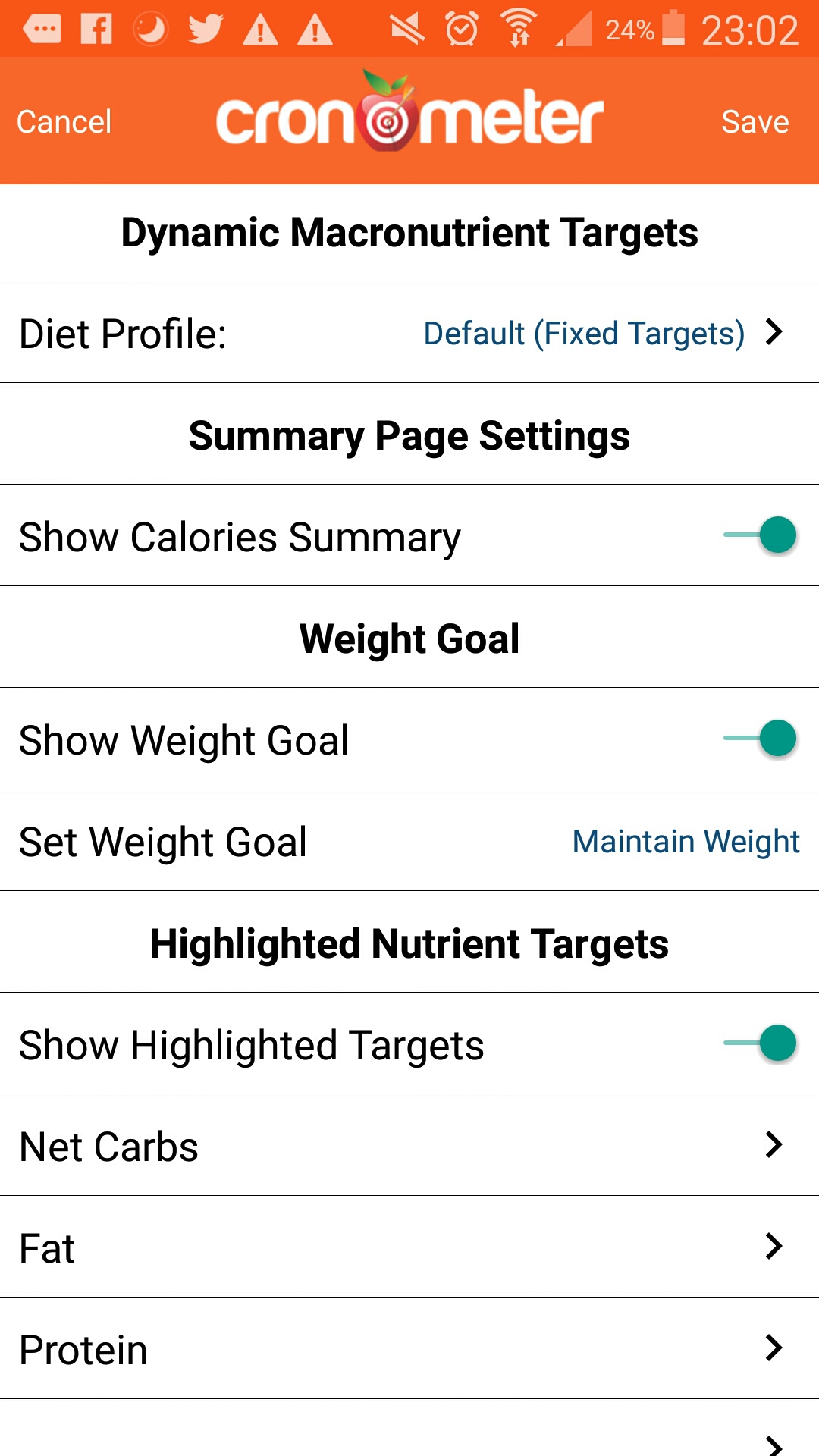
Fig.9 Cronometer settings
As you can see In figure 8, you can set a min and maximum range for each of your macro nutrients and you can select whether you want the app to always work out your net carbs rather than total carbs.
In figure 9 you can choose which information you’d like to show. These settings can all be changed at any time, so you can play around with the settings until you have it looking the way you want.
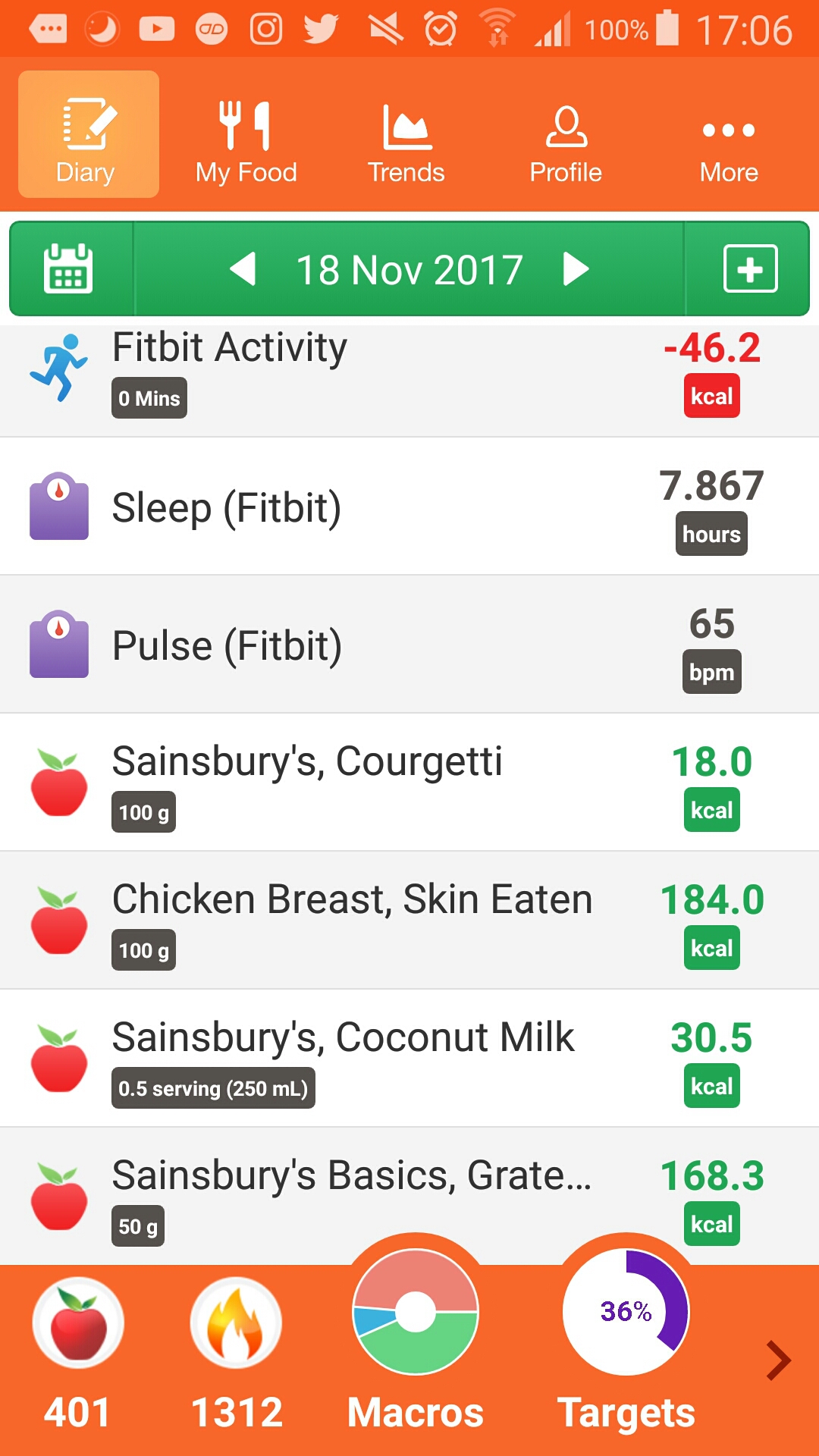
Fig.10 Cronometer diary

Fig.11 daily targets
In Figure 10 you can see the daily Diary which has imported my Fitbit data and you can see all the foods I have entered so far. While in Figure 11 you can see the daily Targets which display the calories and macros in a more visual and colourful way than My Fitness Pal does.
The grammes and percentages are shown on the same progress bars, so you have all the information in one place and the progress pie charts are also on the same page.
Summary
The main differences here are the visuals and the fact that Cronometer doesn’t divide your meals into Breakfast, Lunch, Dinner and Snacks the way that MFP does. Also Cronometer can be set to calculate net carbs, while MFP works with total carbs or net carbs, depending on which items you use. *
Both apps work very well and have enormous databases as well as the ability add recipes and track more than just your carbs, protein and fat. For example, you can choose to track things like your electrolytes which are also super important when on a ketogenic diet.
I hope this little overview has helped you decide which you would most likely prefer and has taken away some of the fear of tracking that so many of us have when we first start our keto journeys.
![]()
Pin “Setting up a Macro Tracker”
Please contact me if you have any questions or if your brain fog is getting in the way of setting up your macros. I will gladly walk you through it.
*USA products have net carbs worked out on the label, while UK products show total carbs, meaning you can deduct the fibre from the carbs to find net carbs. I just use the total carb count, so this way I’ll always stay below my limit.
In part 3 (coming soon) I will show you exactly what you’re allowed to eat and then in part 4 I’ll explain how I plan my meals daily in these apps.
Please let me know if you have found these guides helpful or if you have any more questions.



